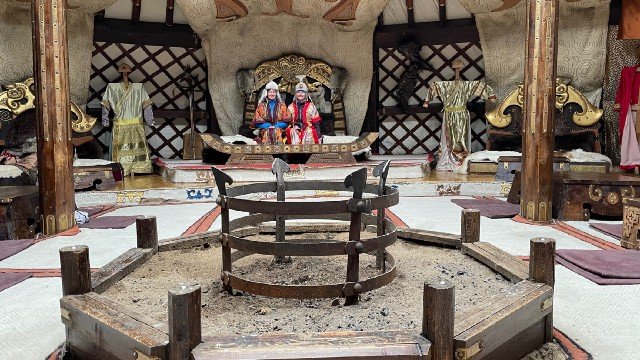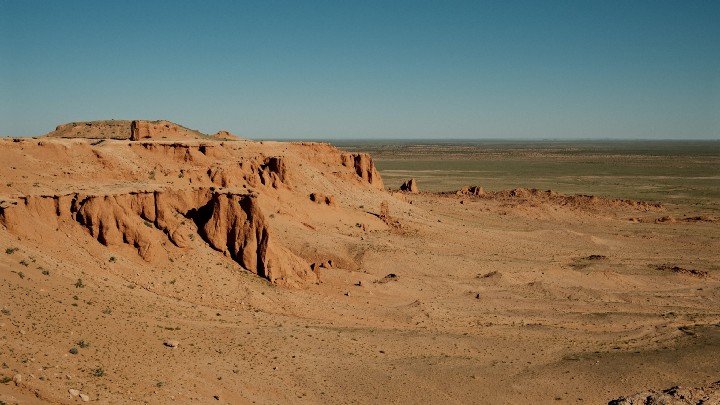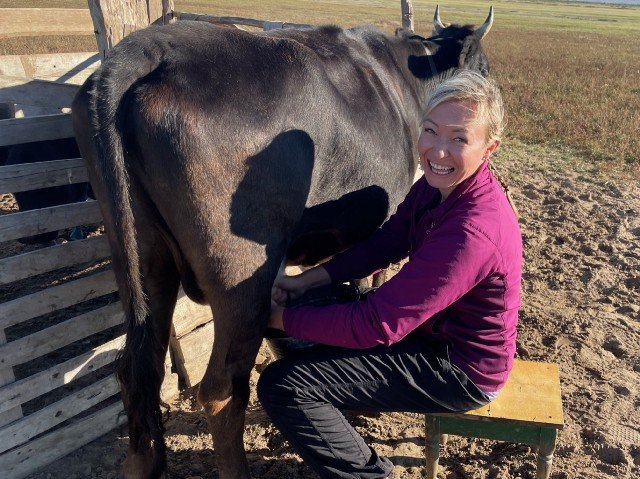Mongolia Cycling Trip
For my final trip of summer break, I was extremely fortunate to join my friend Esther, a fellow Olmsted scholar, on a two-week cycling trip in Mongolia. -C
When Esther first invited me to join her on a two week cycling trip to Mongolia, I knew this was a once in a lifetime opportunity that I couldn’t pass up. We found a wonderful tour guide company called Mongolia Expeditions that arranged the whole trip including transportation to and from the airport, provided all of our meals on the road, organized our COVID tests, and pretty much every other type of logistics that came up. The trip was divided into two parts. First, we spent four days cycling in Khenty located to the East of Mongolia’s capital in Ulaanbaatar. Then, we journeyed South and spent nine days cycling across the Gobi desert.
When we arrived in Mongolia, Es and I discovered that we were the only members of our tour group. Because Mongolia had only recently opening their borders to tourism in July, we were the first foreign tourists to hire Mongolian Expeditions in two years. In addition to Es and myself, the group consisted of a lead guide, a mechanic, a driver, and a chef. A robust Russian 4WD all-terrain van was our support vehicle that fit not only the riders, but the bikes, all of our camping gear, and the cooking equipment. Our guides were genuinely excited for the opportunity to share their beautiful country with us.
A picture of our van with accompanying supplies to give you an idea of our setup.
We began our tour at the Genghis Khan Statue Complex which features a 131 foot tall chrome statue of its namesake. While it certainly made for a great photo-op, Es and I were more captivated by the the stunning panorama of rolling peridot-green hills. True to its nomadic cultural roots, Mongolia remains undeveloped in most areas outside of the cities. We took several minutes to admire the countryside before setting off with our guides on our bikes.
During our first day of the tour, we luxuriated in perfect 70ºF weather. We were only on the road for a short while before our guides veered off onto an unmarked dirt path. That’s when Es and I discovered that virtually all of Mongolia subsists without paved or marked roads. As the snow melts each year, people form new roads with their cars. Befuddled, we asked our guide how he knows where to go. He says Mongolians look out onto the landscape, judge their distance from these markers, and have a kind of feeling of how they need to travel in order to get where they want to go.
Enjoying the views during a lunch break.
Our chef had his first opportunity to demonstrate his capabilities when we stopped for lunch, and he did not disappoint. It was the first of many three course meals we enjoyed during the trip. I honestly don’t know where he kept all the food in our van, but we ate like queens for two weeks.
Exploring our campsite.
After lunch, we continued riding through the beautiful landscape until we settled next to a stream where we set up camp for the first night. Es and I were excited to discover that we each had a tent to ourselves. We also were surprised to find that they carted around a full toilet. When we set up camp for a night, they dug a hole, set the toilet on top, and assembled a small tall tent around it. They also assembled a separate shower tent! For the water, they filled a pump operated shower head with perfectly warmed water. In summary, we were glamping in Mongolia.
The morning was much cooler than the day prior.
The next morning greeted us with slightly cooler temperatures that required a light jacket. Throughout the day, we were gradually working our way uphill towards the top of the hill looking down into a vast valley anchored by rolling green mountains on either side. We screamed down the hill and continued cycling surrounded by this majestic landscape for a good twenty minutes before turning towards the middle of the valley where we set up camp for the evening.
Enjoying a campfire on our second night.
That evening, our chef treated us to his version of a traditional Mongolian meal in which the meat is cooked using fire-heated stones. While the traditional method involves wrapping the meat and stones in an animal’s stomach, he simply placed the hot stones and meat in a pressure cooker and let the meat cook for twenty minutes. Es and I enjoyed relaxing by the fire for warmth as the temperature dropped. Our guide remarked that we had a southerly wind which meant a storm was coming. Right around midnight, I heard horses neighing ominously in the distance. Sure enough, not ten minutes later, the rain started and didn’t stop all night.
Waking up the next morning in a cold tent, I was filled with dread by the thought of riding in the freezing rain. Es was in agreement that riding in that weather would be pretty miserable. We asked the guides if we could instead ride in the van. They visibly exhaled in relief that we weren’t going to insist they lead us around in the rain.
Es and I were so excited to not have to cycle in the freezing rain
For our inclement weather day, we visited a touristy ger camp. A ger is the traditional Mongolian home that can be quickly assembled and disassembled so as to allow the family to roam with their herds as the seasons dictate. They are still utilized to this day. The home is a round single room with a stove in the middle and beds, tables, or couches along the wall. Each part of the ger has a traditional purpose and set-up. At this camp, we got to see what gers looked like in the 13th century, try on different kinds of traditional clothing, and even ride a horse for a little bit. We also sampled traditional dairy products often served when visiting a ger, such as a kind of hard sour cheese, delicious cream collected from the top of boiling milk, and a homemade yogurt drink.
We set up camp that night atop a mountain with the hopes it would protect us from the higher winds down in the valley. It didn’t however block the low temperatures. After shivering through a cold night with sleeping bags that weren’t quite warm enough, we were greeted by a beautiful crisp morning and clear skies. We packed up our camp, hopped on our bikes, and used our exertions to finally warm ourselves back up. After a half day of riding, we completed our first section of the trip and returned to Ulaanbaatar to resupply prior to heading down to the Gobi.
Beautiful sunrise after a freezing night.
In order to get to our starting point for our nine nights in the Gobi desert, we had to first drive a full twelve hours. We arrived after sunset and set up camp. When we awoke the next morning, a beautiful and colorful desert landscape greeted us. Before beginning our cycling for the day, the guides brought us to an archeological site called Bayanzag or “Flaming Cliffs”. It was here that, in the early 20th century, Western archeologists first discovered dinosaur eggs and several other dinosaur fossils. Our guides lamented that none of these discoveries are available for them to see as they’ve all be exported to museums in the West.
“Flaming Cliffs”
After this visit, we enjoyed a beautiful day of riding albeit with strong, challenging winds throughout. Each time we rode past a ger, we had to strategically maneuver ourselves away from ger owner’s dog. Every family living in a ger has at least one dog who stands guard to protect the family from potential intruders. Thankfully our guides were experts in how to chase the dogs away before getting caught up in our bikes.
Incredible views towards the end of our day.
When we arrived at the campsite, we saw that our driver and chef were already preparing dinner. Our driver was by a stream busy washing intestines and inside the cooking tent was a discarded wool carcass. Our chef informed us that he was preparing Gobi mutton for dinner. We enjoyed lamb for the entire next week. Our talented chef found countless ways to use the meat in creative ways so we never got tired of our meals.
Climbing the sand dunes.
The highlight of the following day came at the end when we had the opportunity to climb sand dunes. Es and I huffed and puffed our way up a tall dune. Half way up, we contemplated whether we wanted to continue all the way to the top. With our fatigued legs from cycling, we decided we were satisfied and charged back down the hill.
The next morning, we drove in the van for a couple hours before arriving at a stunning landscape. Our guide warned us to be careful going down hill because the loose gravel could be very slippery. Es and I soon took off and were enjoying the thrill of the downhill with the majestic landscape surrounding us. After cresting a small hill, I was surprised to find a sharp turn for which I had way too much speed. I took a pretty good fall, scraping up my elbow fairly well in the process. This caused a bit of a delay as our guides gave me some basic first-aid. For the remainder of the trip I required a bit of extra attention to make sure my wound stayed clean amidst the dirty sandy conditions.
Our ger for our last night.
On our last night of the journey, we stayed with a family in their ger camp which was essentially a Mongolia take on a Bed and Breakfast. After settling into our ger, we walked across the field to enjoy a traditional meal with our host family. The next morning, Es and I tried our hand at milking cows and got a small peak into what the everyday life was like for this family.
We returned to Ulaanbaatar after breakfast. Upon reaching the hotel, we said goodbye to the wonderful guides who had given us a truly memorable glimpse into the culture and customs of the Mongolian people.


















